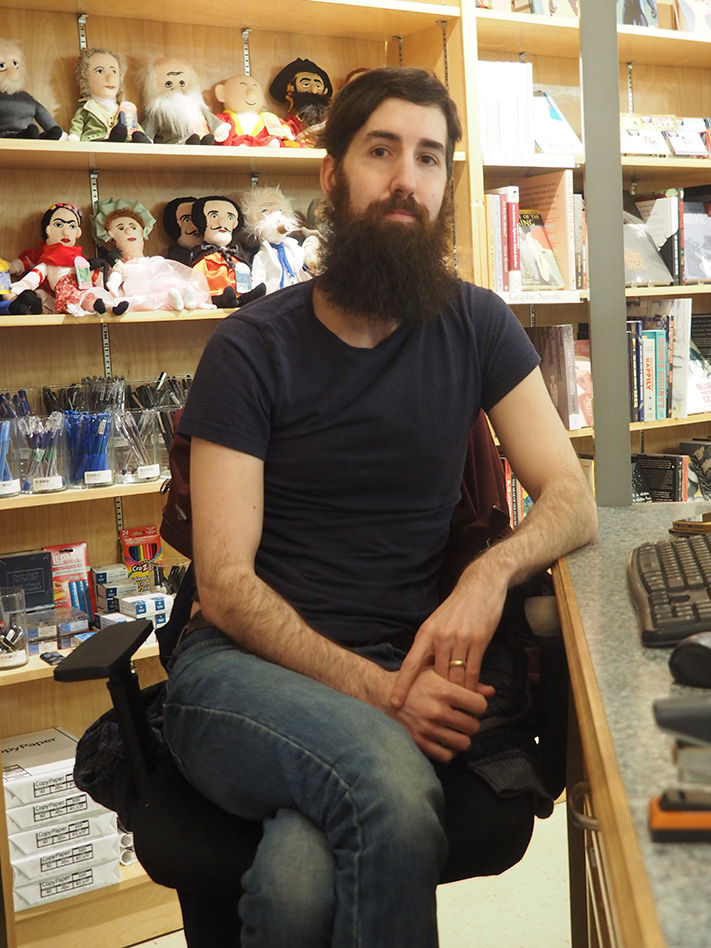FYP Letters is a series of non-curricular notes to keep us in touch over the next days and weeks. They are a combination of original writings and archival ones, including some re-printed FYP News items. — Dr. Susan Dodd, Interim FYP Director.
Moby Dick by Candlelight
an interview with Paul MacKay, Bookseller and Whale Lover
Paul MacKay is likely a familiar figure to many FYP students. He works at the bookstore that most incoming students buy their course books through, and it is a job he enjoys very much.
“Working at the bookstore is a fantastic job.” He said. “I used to work at Chapters in Moncton and Dartmouth. Here, I don’t have to deal with the cheesy sort of merchandise that keeps Chapters afloat. We’re just here to provide a service, which is what I wanna do, which is really nice. It gives me a lot of joy to see people come in and to be able to get their FYP books as cheap as possible, or to see them surprised that we have a book they love.”

Paul MacKay, lover of whales and manager of the King’s Co-Op Bookstore.
His enjoyment of his job is further strengthened by being able to learn from it himself. “People have come to me asking if I’ve read something, and maybe I haven’t, and I’ll order it in.”
He notes that he’s been doing that a lot recently, and that when he does, he’ll get another one for him or for the store itself.
“It really makes it a nice community thing, and not just stuff that I think is cool. It’s stuff that I think is cool, and that other people think is cool.”
One of the main things Paul thinks of as “cool” is whales. And whaling. And whale-related art or products. Really, anything to do with whales. It’s an uncommon, but consuming interest, that all started fifteen years ago.
“It started on a very particular night when I decided I was going to read Moby Dick because I was tired of just hearing about it.” Paul said. He had watched a TV show – The Wire – and the show’s audience were complaining that it took awhile to get you interested. Apparently, the person who wrote it compared it to Moby Dick – you need to get a hundred pages in before you meet Captain Ahab, who everybody knows from Moby Dick.
Paul continues, “So I went okay, I like that show a lot, I’ll finally read Moby Dick. I started reading it in a way that I recommend everyone read it. There was a snowstorm that knocked the power out, so I read the first 200 pages just by a candle. I just absolutely adored that book, I think it’s the greatest American book ever written and I would argue that it’s one of the greatest books period, in my opinion.”
Not everyone would think so, for the very reason that Paul liked it so much. The major complaint about Moby Dick is that there are a lot of whale facts. “If you read the book you could theoretically get in a time machine to the 1800s and be useful on a whaling ship. That’s how specific he is about this stuff.” Paul said. “And I found that really interesting.”
From there, his fascination with whales and whaling continued. He went on to read another book – The Heart of the Sea, the story that prompted the writing of Moby Dick. Then he read another book about whales, this one nonfiction about how they interact and other facts.
“I just find it kind of a fascinating time period and activity, the idea that that’s the closest humans have come to hunting monsters. You have no idea what’s under the water. You just had a stick and your job was to stab this gigantic thing.”
An incredible and chilling image. He does have some more light-hearted whale trivia as well, however. For instance, ambergris. It is an incredibly valuable substance used in high-end perfumes. What it actually is a “whale byproduct” kind of like bile. So, if you stumble on a chunk of whale vomit, you could be rich.
For a less disgusting fact, you can look to the narwhal. Their tusks – really more like a long tooth that protrudes from their forehead – mostly contain nerves. The front part is fine if it’s broken off, but if a break occurs further back, it will hurt very much. Paul compared it to breaking a tooth and having a sensitive nerve exposed. Yikes. Yet if another narwhal sees one with a tusk broken in this way, it can put its tusk in the break and snap the harmless front bit off, essentially plugging the painful hole!
These are great facts, but he has many more. If you’re ever in the mood to hear about whales, drop by the bookstore and ask Paul about it. He can tell you anything from where whaling culture mostly was, to about art done on whale teeth. And he’s right. It is cool.
– by Laya Nickerson, FYP News Student Editor, 2019-20

